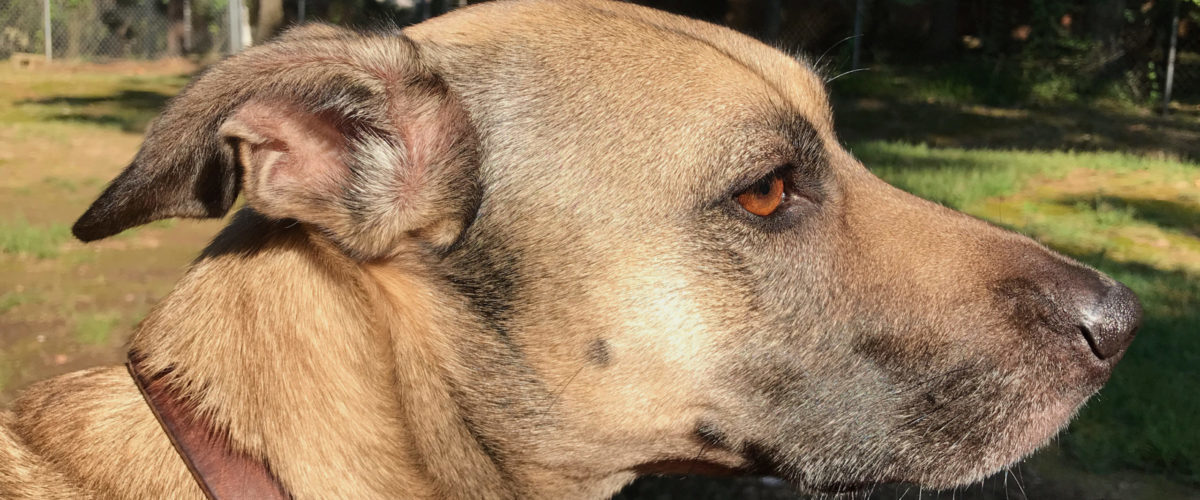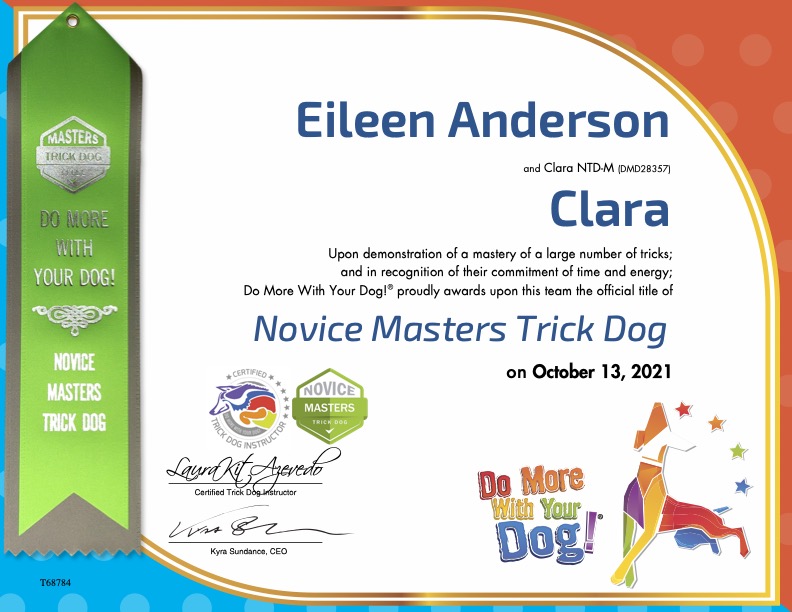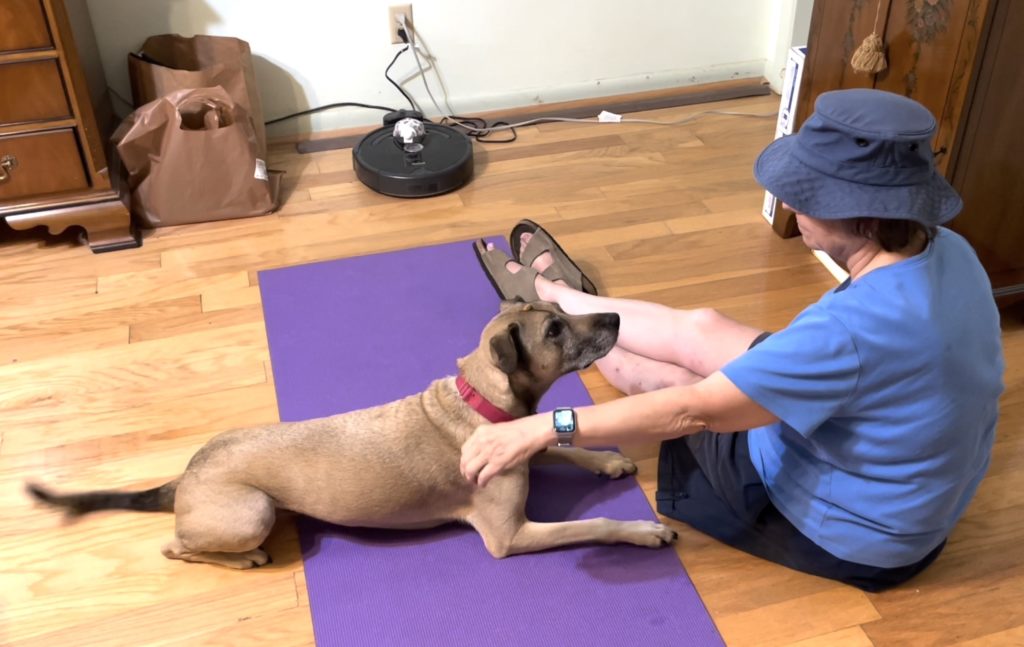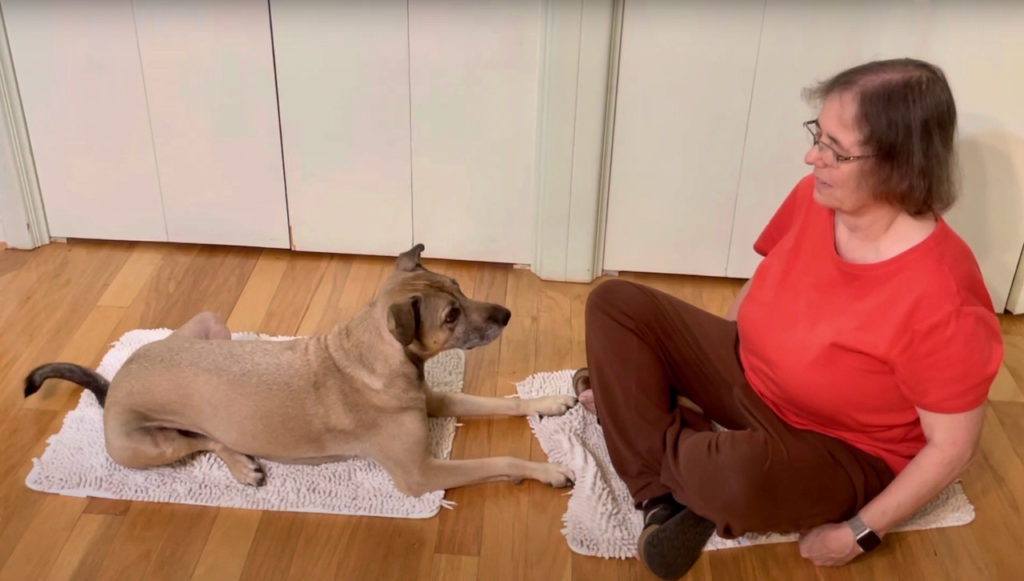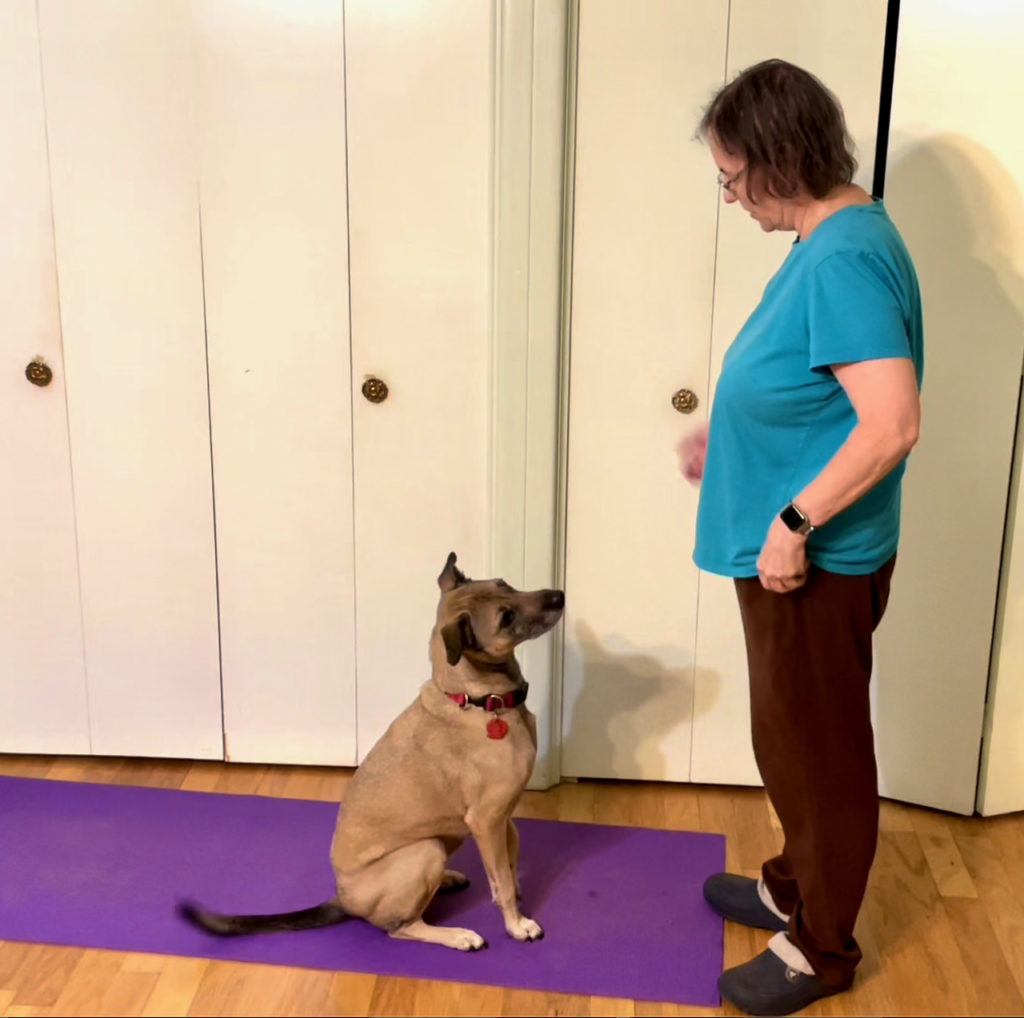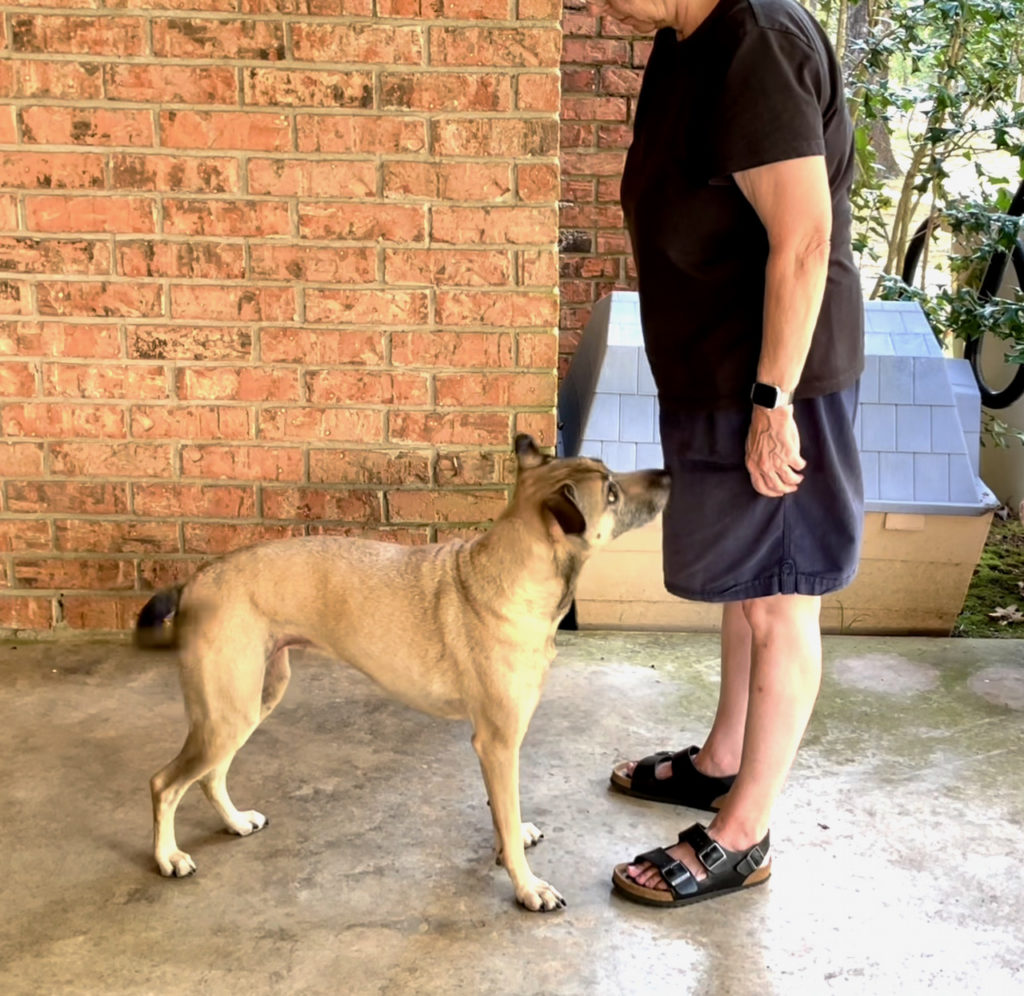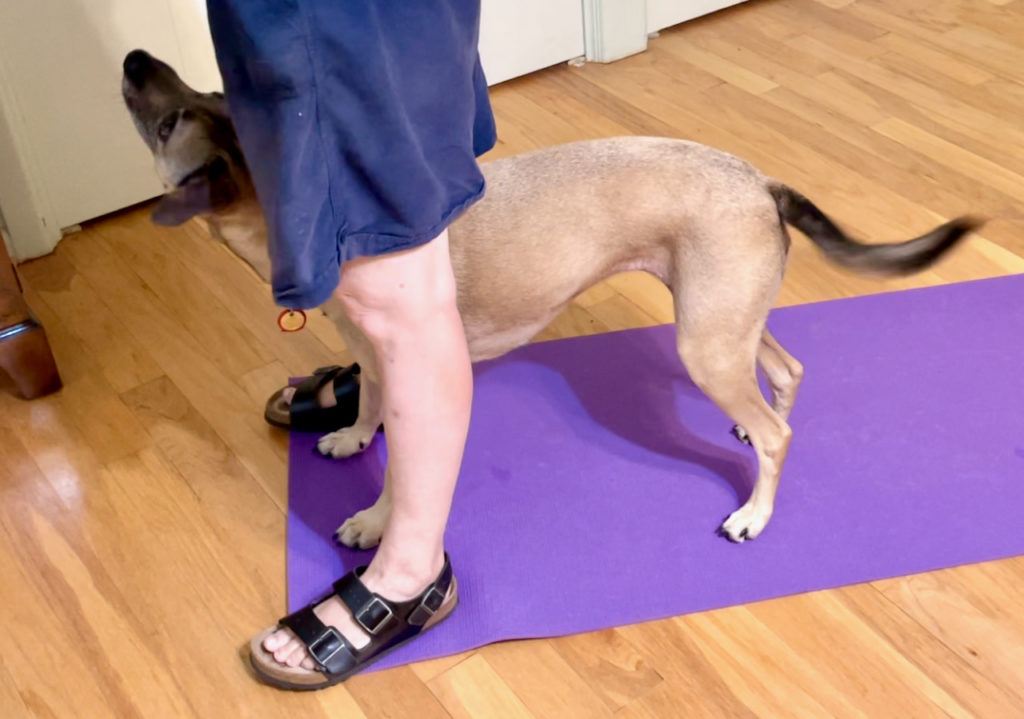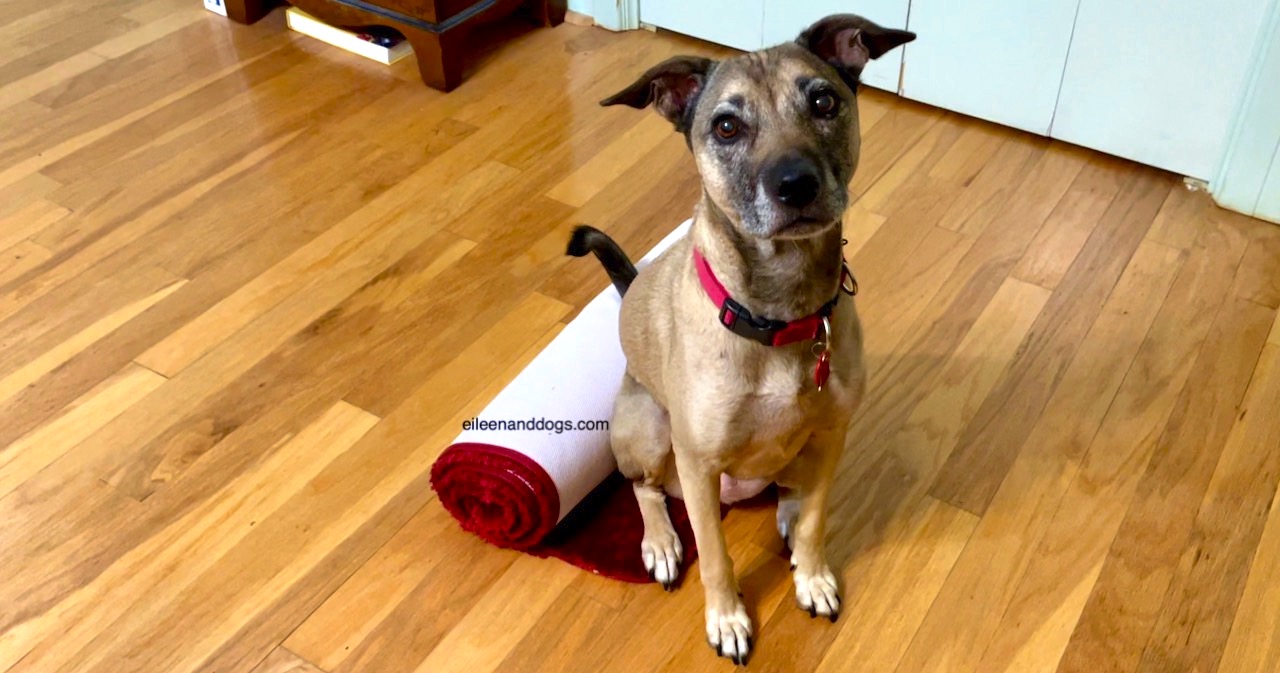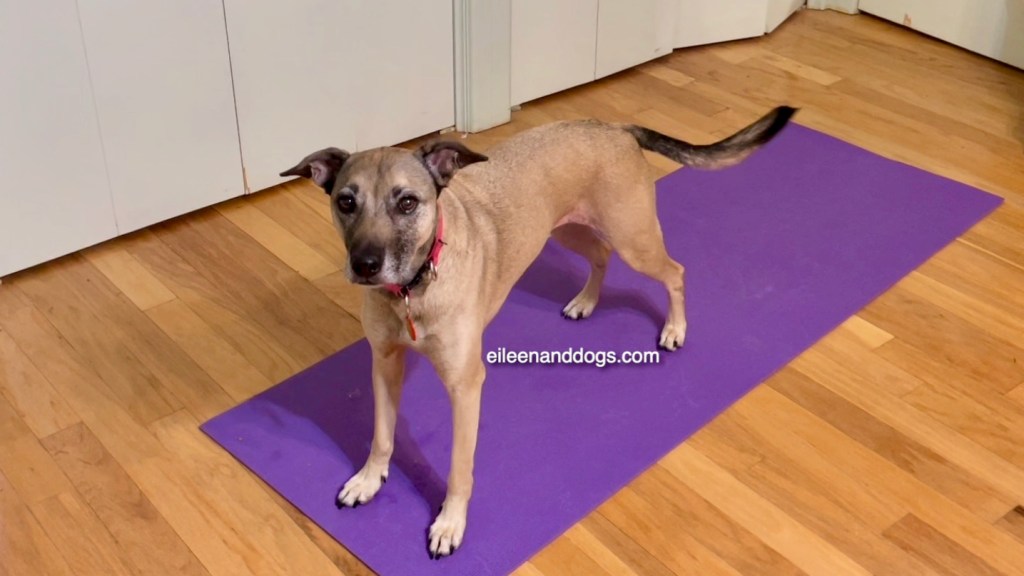Clara’s Novice Masters Trick Dog Title: More Tricks, More Lessons Learned
It’s an oxymoron, as my friend Carol pointed out, but Clara and I earned her Novice Masters Trick Dog title recently. I haven’t had time to post about it until now.
Things We Learned
As usual, the balance between stuff she already knew (get in a crate), tricks we could adapt quickly from stuff she already knew (get in a cardboard box), and completely new stuff (roll out the carpet) was…interesting.
Here are some highlights.
Stand: We finally have a nice stand on cue after our long running debacle. Her stance is a bit crouchy (no idea where that came from), but it’s fixable. What I’ve got is a moderately calm dog with four on the floor and I’m happy! I’m using a hand signal and have no plans for a verbal one. No, no, no way!
Find hidden treats: This should have gone quickly because of all the food searching games we play, but we got haunted with a bit of previous reinforcement history. Clara is so experienced with searching for food that she can find a few pieces of kibble in a very large backyard. For the trick, all she had to do was find three hides of stinky lamb lung in a small area in my bedroom. However, in that room she is patterned to head for the bed and her snuffle mat area where she eats breakfast and often searches. She spent some time over there, off-camera, rather than finding all the easy hides I set.
Rolling out the carpet: I was proud that we finally won our wrestling match with the matching law. In the video, you can see her pause, then flip over the last little corner of the rug. To me, that was better than rolling the whole thing out in one swoop. I could tell she was getting the criteria. It made me very happy.
Platform jump: The directions for this trick say it must be clear that the dog is jumping from platform to platform, not just stepping. We nailed that one!
Tricks We Re-Recorded
There were several tricks I had to tweak and record again when I saw we might not have met some nuance of the requirements. They included the muffin tin game (what could we do wrong with that?), the bang game (whack a board), and eye contact, the last because I had the wrong camera angle.
Finally, we had to re-record the cookie on the nose game. This is one we put some work into, although she already had a good foundation with lots of different Zen/leave-it practice. I taught her to hold still twice as long as the description required, but after we had recorded it, I re-read the rules. It said that the dog would hold the cookie on her nose until the handler reached and took it (or the dog could flip the cookie and eat it for an intermediate trick). We were doing neither. When the time was up, I reached toward her and she dumped it off her head! So I taught her to keep her head still even as I reached for the cookie, and we re-recorded in case the former version was a fail.
I’m pretty proud of that trick, though. My goal was that it would be fun for her. I’ve seen so many miserable-looking dogs with treats piled on their bodies. I was curious, so I finally searched to see how the force-based trainers do this trick, since it is a very common “show-off” trick. The trainer I found, not even one of the worst, held the dog’s chin and scolded whenever they tried to move their head, so the dog learned through physical molding and threats to keep still.
By the way, all that re-reading of the instructions I did? It’s partly because I have considerable ego involvement in this. I don’t plan on screwing up a trick because I misread the directions. But also, re-checking is a habit from my grant writing days. Check the directions, and check them again, and again, and then once more before you turn the damn thing in. Old habits can pay off!
Sloppy Training
Maybe you’ve noticed that I’m not one of those precision trainers (understatement). I am sloppy. I work to get my mechanics decent enough that I am not doing too much of a disservice to my dog, but I hardly ever go that final 20%. But man—watching these videos is an incentive to clean up my act.
Any regular viewer now knows that I keep my treats in my left pocket, because that’s where Clara looks or heads after any behavior. I mention below that I fixed that for our Peekaboo behavior (not shown), so I do know how.
I made the treat orientation worse when working on these tricks because I was often using some kibble from Clara’s breakfast. I was too lazy to take the different kibble out of my pocket so I could pocket her breakfast kibble. So for several tricks I have kibble already in my hand, which I’m waving around in front of her. If you want to see her hand and pocket orientation at its finest, check out the stand behavior about one minute into the video and the hand signals near the end. One of our best tricks is “Look at Eileen’s left hand.” There are so many ways to fix that; I really should!
In the front behavior, I do the classic novice move of taking a step backward and luring her toward me with my two hands together. I made sure this was allowed. I taught Summer a pretty front without that move, since it is disallowed in some levels of obedience. But I’ve never needed formal obedience moves with Clara. The move is included in the official demo video, so I took that shortcut. That’s a lure even without food in the hand, but upon a closer look, I was holding food in that take! I was unintentionally luring her with food.
Many of you have noticed by now that Clara has a superstitious foot lift when she sits. She’s had it forever. A paw lift can be a stress-prompted behavior, but Clara wasn’t a stressy puppy when at home with the other dogs and me, and I suspect that this longstanding addition to her sits is just something I accidentally clicked too much when she was very young. You can see it (barely because of the angle, but I remark on it) in the very first behavior in the video, getting in a box. She holds her paw up for at least three seconds, and I cleverly treat her in that position. Brava, Eileen!
These things I have accidentally trained are annoying for me to look at. It’s my job to remember that they are there because I reinforced them. If I want them to go away, I need to load more reinforcement onto the version I want, not punish or frustrate my dog. There’s a strong human tendency to use punishment to solve problems, but in this case and so many others, it’s completely unfair and uncalled for.
Our Title Video
Things We’re Still Working On
We’ve started our intermediate tricks, but I am keeping my eyes on the prize here, which is to do some great training, not only earn pieces of paper. So we are still working on some of the novice tricks.
Puppy pushups, how about that most basic trick that “everybody” does in obedience schools and many other venues? Hanging my head in shame. We are up to sit, down, sit, down on one treat, but we need to get up to six behaviors rather than four. (She can also do down, sit, down, sit.) I truly do ask my dogs for more than one behavior for a reinforcer at times. But the stand behavior still haunts us, the one that I practiced with her in an aroused state approximately one billion times. And as I extend the number of behaviors on one reinforcer, it usually pops up. “Wait, did you mean this?”
I worked on having her target the long target stick with the enticing ball on the end enough that I was getting a higher percentage of touches than bites, but I haven’t worked the bites down to an acceptable percentage. We still work on it. She’s fine with most anything else I ask her to target.
One of the novice tricks we both enjoyed was peekaboo, where the dog comes up from behind as you are standing and puts their head between your legs. I didn’t include it for the title, because it required three seconds of duration and we didn’t have that. We kept practicing, though, because I wanted to teach her this behavior for when we are out and about (prompted by the Denise Fenzi “squish” behavior). We got our duration, then I noticed she was poking her head through and immediately whipping it toward my treat hand. I started switching hands, so then I got a dog who poked her head through, then immediately whipped her head back and forth, looking for the treat. C’mon, Eileen, think! I could have predicted that if I’d thought about it for half a second. So I thought about it.
I didn’t want to spit treats like I learned to do in competitive obedience. Clara doesn’t like to catch them, and the only dog treats I’m willing to put in my mouth are pieces of mozzarella cheese. Then I remembered Marge Rogers’ method for treating for a straight front behavior. Before treating the dog, she would bring both hands up to her chin, then bring a hand straight down with the treat. So the treat was not only presented in the center position, it was in the center position for a noticeable amount of time before it came to the dog. That did the trick nicely, and now Clara is getting into position, staying there, and looking forward or straight up at my face. Progress!
Related Posts
- Clara’s Novice Trick Title: 15 Tricks and 4 Informative Failures
- Clara’s Stand Disaster and Why She Kept Hopping
- That Damn Roll Out the Carpet Trick
Copyright 2021 Eileen Anderson
